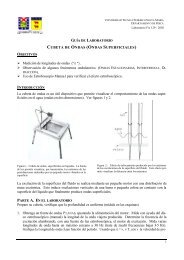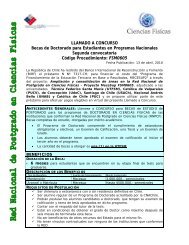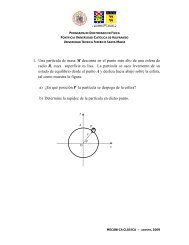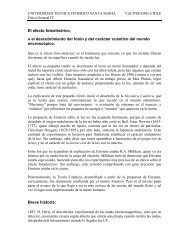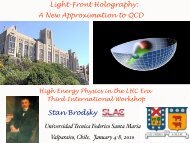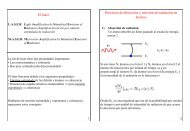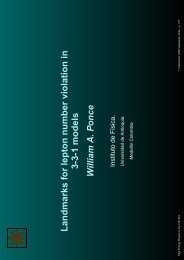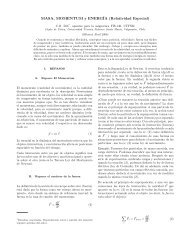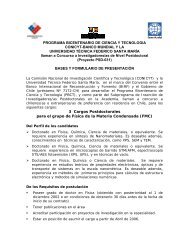Aca - Departamento de Física - Universidad Técnica Federico Santa ...
Aca - Departamento de Física - Universidad Técnica Federico Santa ...
Aca - Departamento de Física - Universidad Técnica Federico Santa ...
Create successful ePaper yourself
Turn your PDF publications into a flip-book with our unique Google optimized e-Paper software.
Py (a.u.)<br />
V Encuentro Sud Americano <strong>de</strong> Colisiones Inelásticas en la Materia<br />
estudia su emisión angular y simetrías<br />
(Fig.3), como así también <strong>de</strong>flexión <strong>de</strong>l proyectil,<br />
por ejemplo para el caso <strong>de</strong> captura<br />
simple. Los fragmentos <strong>de</strong> H + <strong>de</strong> baja energía<br />
están vinculados con la disociación <strong>de</strong>l estado<br />
fundamental <strong>de</strong>l ion H 2 + (GSD).<br />
Para el caso <strong>de</strong> proyectiles neutros en<br />
particular, se comienzan a dar muestras <strong>de</strong> la<br />
transferencia <strong>de</strong> momentos a distintas energías<br />
y análisis <strong>de</strong> procesos con proyectiles<br />
con uno y dos electrones.<br />
Figura 2. Distribución <strong>de</strong> momentos longitudinal P x<br />
y una <strong>de</strong> las componentes transversales P y (dirección<br />
<strong>de</strong>l jet) para el proceso <strong>de</strong> captura simple <strong>de</strong><br />
He + + H 2 a 25 keV.<br />
25<br />
20<br />
15<br />
10<br />
5<br />
0<br />
-5<br />
-10<br />
-15<br />
-20<br />
-25<br />
-30<br />
-30 -25 -20 -15 -10 -5 0 5 10 15 20 25<br />
Px (a.u)<br />
100<br />
10<br />
1<br />
1<br />
10<br />
100<br />
180<br />
9000<br />
8500<br />
8000<br />
7500<br />
7000<br />
6500<br />
6000<br />
5500<br />
5000<br />
4500<br />
4000<br />
3500<br />
3000<br />
2500<br />
2000<br />
1500<br />
1000<br />
500<br />
0<br />
150<br />
210<br />
120<br />
240<br />
(grados)<br />
90<br />
270<br />
Figura 3. Emisión angular <strong>de</strong> los fragmentos <strong>de</strong> H +<br />
en la disociación <strong>de</strong>l estado fundamental GSD<br />
H 2<br />
+<br />
(1s g<br />
) → H + + H o (1s) para el sistema<br />
He + + H 2 →He o + H + + H (captura y excitación).<br />
Círculos llenos 200 keV, círculos abiertos 25 keV.<br />
Referencias<br />
60<br />
300<br />
30<br />
330<br />
0<br />
100<br />
10<br />
1<br />
1<br />
10<br />
100<br />
180<br />
(grados)<br />
[1] M. A. Abdallah, et al., Phys. Rev. A, 62,<br />
012711, (2000).<br />
[2] V. V. Afrosimov, et al., Sov. Phys. JETP, 29,<br />
4, (1969).<br />
[3] E. Horsdal Pe<strong>de</strong>rsen and P. Hvelplund, J.<br />
Phys. B : Atom. Mol. Phys., 7, 132, (1974).<br />
[4] M. H. Rees. Physics and Chemistry of the<br />
Upper Atmosphere. Cambridge Atmospheric<br />
and Space Science Series. (1989).<br />
[5] Weihong Liu and D. R. Schultz, The Astrophysical<br />
Journal, 530 :500-503, (2000).<br />
[6] Jürgen Kiefer, Biological Radiation Effects,<br />
Springer-Verlag, (1990).<br />
150<br />
210<br />
120<br />
240<br />
90<br />
270<br />
60<br />
300<br />
30<br />
330<br />
0<br />
78 Valparaíso, Chile



